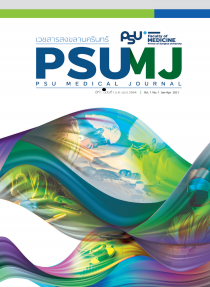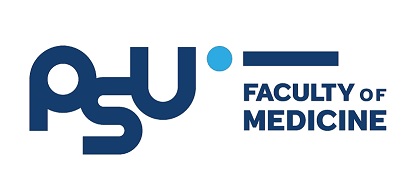Vitamin D: An Essential Micronutrient for Bone Health
Vitamin D for Bone Health
DOI:
https://doi.org/10.31584/psumj.2021246040Keywords:
vitamin D, vitamin D in breastmilk, vitamin D deficiency, vitamin D insufficiencyAbstract
Vitamin D is an essential micronutrient in children for bone mineralization and bone growth. There are two forms of natural vitamin D, vitamin D2 and vitamin D3. Natural vitamin D is obtained from 2 main sources, dietary vitamin D intake and cutaneous vitamin D synthesis from sunlight exposure. Natural vitamin D requires a 2-step enzymatic hydroxylation process to be turned into active form of 1,25-dihydroxyvitamin D, firstly, 25-hydroxylation in the liver, and secondly, 1α-hydroxylation in the kidneys. Although breast milk is highly nutritive containing adequate amounts of most important vitamins, it contains only a small amount of vitamin D, approximately 15-50 IU/L, which does not reach the recommended daily requirement of 400 IU for infants. Exclusively breastfed infants are at risk to develop vitamin D deficiency if sunlight exposure is limited. Despite the excess of sunshine for the whole year in Southeast Asian countries including Thailand, various studies have found that more than 30.0% of children and adolescents had vitamin D insufficiency. The factors associated with vitamin D insufficiency in children include maternal vitamin D deficiency, exclusively breastfed as infants, insufficient daytime outdoor activities, use of sunscreens, extensive skin coverage by clothing, and lack of vitamin D supplementation and dietary fortification. To prevent vitamin D deficiency in infants, a global consensus in 2016 recommended that vitamin D supplementation should be included in routine national health care programs along with other essential micronutrients and immunizations.
References
Charoenngam N, Shirvani A, Holick MF. Vitamin D for skeletal and non-skeletal health: What we should know. J Clin Orthop Trauma 2019;10:1082-93.
Chang SW, Lee HC. Vitamin D and health-The missing vitamin in humans. Pediatr Neonatol 2019;60:237-44.
Florencio-Silva R, Sasso GR, Sasso-Cerri E, Simões MJ, Cerri PS. Biology of bone tissue: structure, function, and factors that influence bone cells. Biomed Res Int 2015;2015: 421746.
Stoffman N, Gordon CM. Vitamin D and adolescents: what do we know? Curr Opin Pediatr 2009;21:465-71.
Holick MF, Binkley NC, Bischoff-Ferrari HA, Gordon CM, Hanley DA, Heaney RP, et al. Endocrine Society. Evaluation, treatment, and prevention of vitamin D deficiency: an Endocrine Society clinical practice guideline. J Clin Endocrinol Meta 2011;96:1911-30.
Misra M, Pacaud D, Petryk A, Collet-Solberg PF, Kappy M. Drug and Therapeutics Committee of the Lawson Wilkins Pediatric Endocrine Society. Vitamin D deficiency in children and its management: review of current knowledge and recommendations. Pediatrics 2008;122:398-417.
Munns CF, Shaw N, Kiely M, Specker BL, Thacher TD, Ozono K, et al. Global consensus recommendations on prevention and management of nutritional rickets. J Clin En docrinol Metab 2016;101:394-415.
Wilson LR, Tripkovic L, Hart KH, Lanham-New SA, on behalf of the D2-D3 Study Team. Vitamin D deficiency as a public health issue: using vitamin D2 or vitamin D3 in future fortification strategies. Proc Nutr Soc 2017;76:392-9.
Yeh EB, Barbano DM, Drake MA. Vitamin fortification of fluid milk. J Food Sci 2017;82:856-64.
Itkonen ST, Erkkola M, Lamberg-Allardt CJE. Vitamin D fortification of fluid milk products and their contribution to vitamin D intake and vitamin D status in observational studies - A review. Nutrients 2018;10:1054.
Nair R, Maseeh A. Vitamin D: The “sunshine” vitamin. J Pharmacol Pharmacother 2012;3:118-26.
Engelsen O. The relationship between ultraviolet radiation exposure and vitamin D status. Nutrients 2010;2:482-95.
Bogh MKB. Vitamin D production after UVB: Aspects of UV-radiated and personal factors. Scand J Clin Lab Invest 2012;72(Suppl 243):S24-31.
Chakhtoura M, Rahme M, Chamoun N, El-Hajj Fuleihan G. Vitamin D in the Middle East and North Africa. Bone Rep 2018;8:135-46.
van der Pligt P, Willcox J, Szymlek-Gay EA, Murray E, Worsley A, Daly RM. Associations of maternal vitamin D deficiency with pregnancy and neonatal complications in developing countries: A systematic review. Nutrients 2018;10:640.
van Schoor N, Lips P. Glo al overview of vitamin D status.Endocrinol Metab Clin North Am 2017;46:845-70.
Bens G. Sunscreens. Adv Exp Med Biol 2014;810:429-63.
Osterwalder U, Herzog B. Sun protection factors: worldwide confusion. Br J Dermatol 2009;161(Suppl 3):S13-24.
World Health Organization. Nutrient adequacy of exclusive breastfeeding for the term infant during the first six months of life. Geneva: WHO; 2002.
Lessen R, Kavanagh K. Position of the academy of nutrition and dietetics: promoting and supporting breastfeeding. J Acad Nutr Diet 2015;115:444-9.
Erick M. Breast milk is conditionally perfect. Med Hypotheses 2018;111:82-9.
Martin CR, Ling PR, Blackburn GL. Review of infant feeding: key features of breast milk and infant formula. Nutrients 2016;8:279.
Bae YJ, Kratzsch J. Vitamin D and calcium in the human breast milk. Best Pract Res Clin Endocrinol Metab 2018;32:39-45.
Thandrayen K, Pettifor JM. Maternal vitamin D status: implications for the development of infantile nutritional rickets. Endocrinol Metab Clin North Am 2010;39:303-20.
Gordon CM, Feldman HA, Sinclair L, Williams AL, Kleinman PK, Perez-Rossello J, et al. Cox JE. Prevalence of vitamin D deficiency among healthy infants and toddlers. Arch Pediatr Adolesc Med 2008;162:505-12.
Keikha M, Bahreynian M, Saleki M, Kelishadi R. Macro-and micronutrients of human milk composition: Are they related to maternal diet? A comprehensive systematic review. Breastfeed Med 2017;12:517-27.
Hollis BW, Wagner CL, Howard CR, Ebeling M, Shary JR, Smith PG, et al. Maternal versus infant vitamin D supple mentation during lactation: A randomized controlled trial. Pediatrics 2015;136:625-34.
Roth DE. Maternal postpartum high-dose vitamin D3 supplementation (6400 IU/day) or conventional infant vitamin D3 supplementation (400 IU/day) lead to similar vitamin D status of healthy exclusively/fully breastfeeding infants by 7 months of age. Evid Based Med 2016;21:75.
Wagner CL, Hulsey TC, Ebeling M, Shary JR, Asghari G, Howard CR, et al. Safety aspects of a randomized clinical trial of maternal and infant vitamin D supplementation by feeding type through 7 months postpartum. Breastfeed Med 2020;15:765-75.
Holick MF, Binkley NC, Bischoff-Ferrari HA, Gordon CM, Hanley DA, Heaney RP, et al. Endocrine Society. Evaluation, treatment, and prevention of vitamin D deficiency: an Endocrine Society clinical practice guideline. J Clin Endocrinol Metab 2011;96:1911-30.
Williams AM, Suchdev PS. Assessing and improving childhood nutrition and growth globally. Pediatr Clin N Am 2017;64:755–68.
Poh BK, Rojroongwasinkul N, Nguyen BK, Sandjaja, Ruzita AT, Yamborisut U, et al. SEANUTS Study Group. 25-hydroxyvitamin D demography and the risk of vitamin D insufficiency in the South East Asian Nutrition Surveys (SEANUTS). Asia Pac J Clin Nutr 2016;25:538-48.
Nimitphong H, Holick MF. Vitamin D status and sun exposure in southeast Asia. Dermatoendocrinol 2013;5:34-7.
Chavasit V, Kasemsup V, Tontisirin K. Thailand conquered under-nutrition very successfully but has not slowed obesity. Obes Rev 2013;14(Suppl 2):S96-105.
Charoenngam N, Sriussadaporn S. Prevalence of inadequate vitamin D status in ambulatory Thai patients with cardiometabolic disorders who had and had no vitamin D supplementation. J Med Assoc Thai 2018;101:739-52.
Rojroongwasinkul N, Kijboonchoo K, Wimonpeerapattana W, Purttiponthanee S, Yamborisut U, Boonpraderm A, et al. SEANUTS: the nutritional status and dietary intakes of 0.5-12-year-old Thai children. Br J Nutr 2013;110(Suppl 3):S36-44.
American Academy of Pediatrics, Committee on Environmental Health. Ultraviolet light: a hazard to children. Pediatrics 1999;104(2 pt1):328–33.
Downloads
Published
How to Cite
Issue
Section
License
Copyright (c) 2021 Author and Journal

This work is licensed under a Creative Commons Attribution-NonCommercial-NoDerivatives 4.0 International License.








